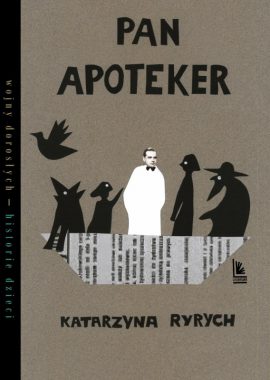Author: Katarzyna Ryrych
Illustrator: Katarzyna Ryrych
Year: 2018
Publisher: Literatura
Place of publication: Łódź
Pages: 117
ISBN: 9788376726403
Notes: “Wojny dorosłych – historie dzieci” series

Mr. Apoteker is another one of Katarzyna Ryrych stories about the Holocaust, after Bombka babci Zilbersztajn (Grandma Zilbersztajn’s Christmas Bauble). This time, the author has decided to tell her young reader the story of Tadeusz Pankiewicz, the owner of “Under the Eagle” Pharmacy (Apteka Pod Orłem) which was incorporated into the territory of the Krakow Ghetto, although only Christians worked there. This allowed Pankiewicz to help Jewish victims locally, as he could run his business and leave the Jewish quarter freely. The reader follows the fates of a little girl Bluma, her family and her friends, learning about the world of the Kraków Ghetto (with the ruthless character of the head of the Jewish police Symche Spire), and observing the exacerbation of anti-Jewish repressions which lead to “displacement”, or – as the reader may suspect – transportation to the forced labour camp in Płaszów, and from there: to extermination camps.
Mr. Apoteker is the first Polish children’s story about the Kraków Ghetto. It draws attention to the ghetto’s characteristic location in the Podgórze district and its wall which visually resembled a row Jewish tombstones (matzevahs). Importantly, the presented history of World War Two is accompanied by much information on Jewish culture and religion, which is rare for Polish children’s and young adult books on the Holocaust. The main body of the text and the footnotes teach the reader about Jewish holidays (e.g. Purim, Shavuot, Lag BaOmer), the contents of the Talmud and Torah, terms such as Kaballah, matzo and cheder, or dybbuk, Haman and golem.
Bibliography:
- Karczewska, A., Pamięć i empatia. O dziecięcej literaturze Zagłady, [in:] Pamięć o Zagładzie w polskojęzycznej i niemieckojęzycznej literaturze autorek i autorów drugiego oraz trzeciego pokolenia post-Szoah / Das Gedächtnis an die Shoah in der polnischen und deutschsprachigen Literatur von Autorinnen und Autoren der zweiten und dritten Post-Shoah-Generation, eds. I. von der Lühe, S.J. Żurek, Lublin 2019, pp. 265–300
- Rybak, K. Dzieciństwo w labiryncie getta. Recepcja mitu labiryntu w polskiej literaturze dziecięcej o Zagładzie, Warszawa 2019 (p. 15, 69, 92);
- Rybak, K., Stosunki polsko-żydowskie i Zagłada w polskiej literaturze dziecięcej XXI wieku, [in:] Stosunki polsko-żydowskie, vol. 2, Kultura. Literatura, sztuka i nauka w XX wieku, ed. Z. Trębacz, Warszawa 2020, pp. 171–187 (p. 174, fn. 7; 178);
- Rybak, K., Zagłada i ideologia w polskiej literaturze dziecięcej XXI wieku, „Narracje o Zagładzie”, no. 1(7), 2021, pp. 155–173 (p. 162, 164);
- Rybak, K., „Zupełnie inne miasto”. Obrazy warszawskiego getta w polskiej literaturze dziecięcej XXI wieku, „Dzieciństwo. Literatura i Kultura”, no. 3(1), 2021, pp. 67–84 (p. 69, fn. 6);
- Rybak, K., Obrazowanie Zagłady. Narracje holokaustowe w polskiej literaturze XXI wieku dla dzieci i młodzieży, Warszawa 2023;
- Wawer, K., Lekcje (polskiego) z wielokulturowości. Praca z serią Wojny dorosłych – historie dzieci w szkole podstawowej na wybranych przykładach, „Polonistyka. Innowacje”, no. 13, 2021, pp. 145–161 (p. 146).